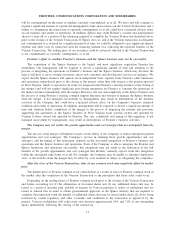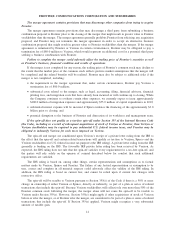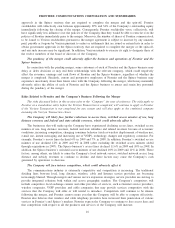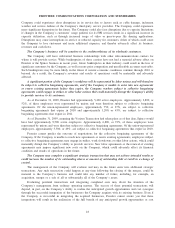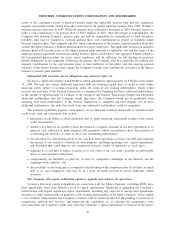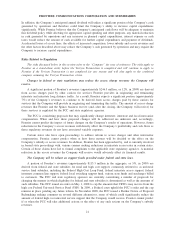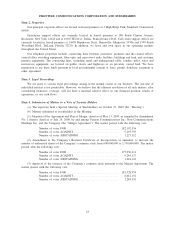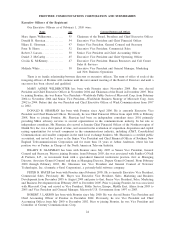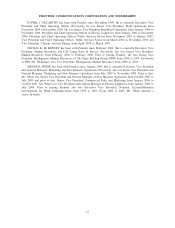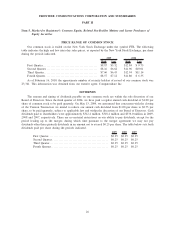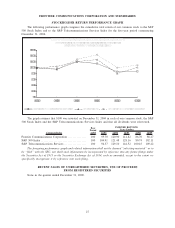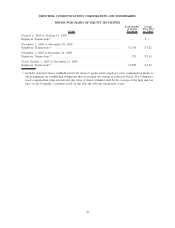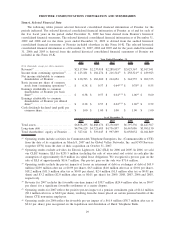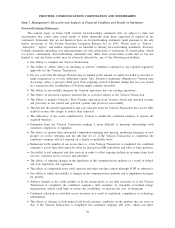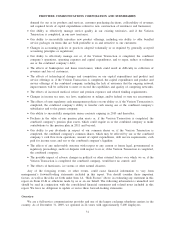Frontier Communications 2009 Annual Report Download - page 24
Download and view the complete annual report
Please find page 24 of the 2009 Frontier Communications annual report below. You can navigate through the pages in the report by either clicking on the pages listed below, or by using the keyword search tool below to find specific information within the annual report.Federal subsidies representing interstate access support, rural high cost loop support and local switching
support represented approximately $69.1 million, or 3%, of Frontier’s revenues in 2009. Frontier currently
expects that as a result of both an increase in the national average cost per loop and a decrease in Frontier’s and
the Spinco business’s cost structure, there will be a decrease in the subsidy revenues Frontier and the Spinco
business will earn in 2010 through the Federal High Cost Loop Fund. The amount of federal interstate access
support funds received may also decline as that fund is also subject to a national cap and the amounts allocated
among carriers within that cap can vary from year to year. State subsidies represented approximately $8.7
million, or less than 1%, of Frontier’s revenues in 2009. Approximately $35.5 million, or 2%, of Frontier’s
2009 revenues, represents a surcharge to customers (local, long distance and interconnection) to recover
universal service fund contribution fees which are remitted to the FCC and recorded as an expense in “other
operating expenses.” Frontier expects that approximately 5% of the Company’s revenue will continue to be
derived from federal and state subsidies, and from surcharges to customers.
The Company and its industry will likely remain highly regulated, and the Company will likely incur
substantial compliance costs that could constrain its ability to compete in its target markets.
As an incumbent local exchange carrier, the Company will be subject to significant regulation from
federal, state and local authorities. This regulation will restrict the Company’s ability to change its rates,
especially on its basic services and its access rates, and will impose substantial compliance costs on the
Company. Regulation will constrain the Company’s ability to compete and, in some jurisdictions, it may
restrict how the Company is able to expand its service offerings. In addition, changes to the regulations that
govern the Company may have an adverse effect upon its business by reducing the allowable fees that it may
charge, imposing additional compliance costs or otherwise changing the nature of its operations and the
competition in its industry.
Pending FCC rulemakings and state regulatory proceedings, including those relating to intercarrier
compensation and universal service, could have a substantial adverse impact on the Company’s operations.
Risks Related to Technology
The risks discussed below in this section refer to the “Company” for ease of reference. The risks apply to
Frontier as a stand-alone entity before the Verizon Transaction is completed and will continue to apply to
Frontier if the Verizon Transaction is not completed for any reason and will also apply to the combined
company assuming the Verizon Transaction closes.
In the future, as competition intensifies within the Company’s markets, the Company may be unable to
meet the technological needs or expectations of its customers, and may lose customers as a result.
The communications industry is subject to significant changes in technology. If the Company does not
replace or upgrade technology and equipment, it may be unable to compete effectively because it will not be
able to meet the needs or expectations of its customers. Replacing or upgrading the combined infrastructure
could result in significant capital expenditures.
In addition, rapidly changing technology in the communications industry may influence the Company’s
customers to consider other service providers. For example, the Company may be unable to retain customers
who decide to replace their wireline telephone service with wireless telephone service. In addition, VoIP
technology, which operates on broadband technology, now provides the Company’s competitors with a
competitive alternative to provide voice services to the Company’s customers, and wireless broadband
technologies may permit the Company’s competitors to offer broadband data services to the Company’s
customers throughout most or all of its service areas.
Item 1B. Unresolved Staff Comments
None.
22
FRONTIER COMMUNICATIONS CORPORATION AND SUBSIDIARIES


